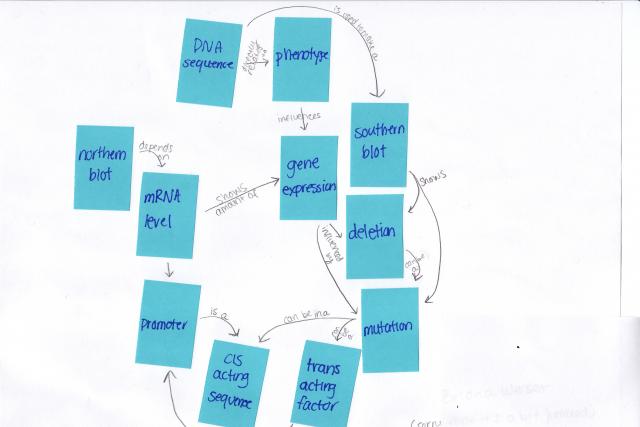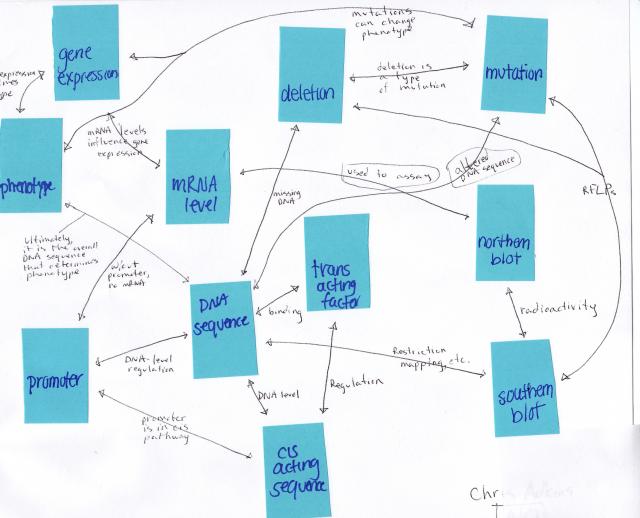|
Context I
gathered data for this project in the undergraduate Genetics course at
Vanderbilt. Biology majors take this course after a year of
introductory biology. The course is required for most of the biology
major programs. Students in the course have generally done well in
introductory courses, but many have difficulty with the Genetics course
because it requires a different way of thinking, applying knowledge,
and problem solving than their previous biology courses. I am gathering
the data for this project as a guest lecturer - I am no longer a
teaching assistant in the course. The students are familiar with me,
however, because I gave two guest lectures earlier in the semester.
This course has been recently redesigned, with help from the Center for
Teaching, with the ultimate goal of helping students to "think like
geneticists." One main enduring understanding from this course is to
identify a problem, formulate a hypothesis, design an experiment, and
interpret the results.
|
|
|
Questions In my project, I investigated these questions:
1. Can concept maps reveal specific misconceptions held by students that may be roadblocks to learning?
2. Can instructor-led concept mapping sessions address these misconceptions and promote students' ability to apply knowledge?
I
became interested in these questions as a teaching assistant and
refined my focus during the first two cycles of the teaching
certificate program. As a teaching assistant for the Genetics course, I
observed that students had a firm grasp of the "facts" of genetics, but
had difficulty applying this knowledge to new problems. I believe that
one reason this occurs is that students don't see the "big picture," a
common complaint of instuctors across disciplines. If students don't
have an understanding of how concepts are connected, they will have
trouble applying multiple concepts to answer a single question, a
common task in the Genetics course. As part of the teaching certificate
program, I investigated the literature on designing learning
experiences that help students create a conceptual framework of ideas
in a course. Literature on teaching and learning in biology has shown
that the use of concept maps, both in course design and as an
assessment tool, may help achieve this goal. I set out to test the
hypothesis that concept mapping exercises increase students' "big
picture" understanding, which may aid them in applying knowledge to new
problems. I believed that these exercises would also be helpful to the
instructor in assessing students' understanding and possible
misconceptions.
|
|
|
|
Gathering Evidence To
determine whether concept maps are valuable to assess student
understanding, I asked students to individually create a concept map of
eleven concepts (of my choosing) they had recently studied. I wrote the
concepts on post-it notes so that students could first arrange the
concepts on the page, with the most over-reaching or important concepts
at the top of the page. I then asked them to create connections between
the concepts with arrows and a description of how the concepts were
related. To analyze these maps, I first looked for general trends and
then scored each map based on three criteria: hierarchy, accuracy, and
descriptiveness. I hoped to identify any misconceptions students had,
and assess their level of understanding. As
a second part of this project, I created my own concept maps that
addressed misconceptions I saw in student maps, and would also
hopefully help them review for the final exam. I presented these maps
in an interactive review session, and asked students to fill out a
survey asking whether they thought the session helped increase their
understanding of the concepts. |
|
|
Findings When
analyzing student maps, I first scored each map using three criteria:
hierarchical order of concepts, level of descriptiveness, and accuracy
of descriptions. I then looked through the maps to identify any common
misconceptions. Interestingly (and unexpectedly), I observed that many
students used very absolute terms when describing connections between
concepts, while these connections (to an expert) are very rarely
absolute. An example of a student concept map with very absolute
descriptions is shown in the Concept map #1 box below. Concept map #2
shows another student map that is not only more descriptive, but also
uses qualifying words such as "can affect" and "can change" to describe
connections. Concept map #1 was produced by a student that did poorly
in the class, while map #2 was made by an A student. When concept maps
were separated based on the use of absolute vs. conditional terms,
there was a 12-point difference in exam averages between the two groups
(see figure below). This indicates that the use of absolute language
may predict lower exam scores.
As a second part of this project, I designed a review session for the
final exam where I addressed the misconception about the absoluteness
of connections between certain concepts. For example, in the first
concept mapping exercise, many students said that a Southern blot shows
mutations that affect phenotype. In fact, this is only sometimes the
case. To address this, I shared a concept map about southern blots in
an interactive review session where nodes containing different types of
mutations and the southern blot node were connected with different
arrows indicating a "sometimes," "always," or "never" connection. I
then asked students that attended this optional session to fill out a
survey in which I asked if the exercise helped them better understand
the connections between the material and if it would help them on the
final exam. Student comments were very positive, and indicated that the
concept maps "help create a clear and easy way to integrate and
connect" information in a way that would be helpful for them on the
exam. In conclusion, I have
found that analysis of concept maps can identify common misconceptions.
Specifically, many students inacurrately describe connections with
absolute terms, which may predict lower exam scores. Finally,
instructor-led concept mapping exercises can address these
misconceptions and help students connect and integrate information.
|
|
 Student Concept Map 1
Student Concept Map 1 |
|
|
 Student Concept Map 2
Student Concept Map 2 |
|
|
|
|
Resources and Obstacles The
Genetics instructors at Vanderbilt University, especially Katherine
Friedman and Mark Woelfle, were allies to me for this project. They
gave me the opportunities to teach and gather data in the Genetics
course. Dr. Friedman was also a knowledgeable resource when designing
my concept mapping exercises. Jeff Johnston, an assistant director at
the CFT, helped me gather data and refine my project. Dr. Johnston also
led a group that recently redesigned the Genetics course at Vanderbilt.
Being a part of this group gave me valuable insight into the
difficulties students have in Genetics, and ways that I might use this
project to help further identify and possibly alleviate these problems.
My Cycle II working group, led by Jeff Sheehan, helped me reflect on
the use of concept maps in the classroom. My Cycle III working group,
led by Derek Bruff, has helped me collect and analyze data for this
project in new and exciting ways. Being
a part of the Biological Sciences department also assisted me in this
project. The department values teaching, and gives every graduate
student the opportunity to teach. The department has also allowed me to
serve as a teaching assistant more semesters than required to help me
practice and refine my teaching. As a graduate student in biology, I
have learned how to be a scientist: how to design experiments, gather,
and interpret data. This knowledge helped me design my scholarship of
teaching and learning project, and to analyze and interpret the results. One
of my main difficulties with this project was a dearth of teaching
opportunities. Since I am no longer a teaching assistant in Genetics, I
have no official contact with students. I had to gather data during one
class session when the professor was out of town, and during an
optional session that less than 1/3 of the class attended. Therefore,
the amount of data I have is limited, and I don't have additional
opportunities to refine the project or gather more data. I plan to
continue this study next year, however, when I design and implement my
own courses.
|
|
|
Looking Ahead When
planning my own courses next year, I will create a concept map for each
course I design. I think that this will ensure that each lecture helps
achieve my learning goals for the course and fits into a larger
picture. Periodically sharing this map with students will help them
create a conceptual framework for the course, which has been shown to
be an essential part of teaching for learning.
I also plan to use group concept mapping exercises in class to assess
student learning. These exercises are fun for students and can help
them think about the information in different ways. As shown from this
project, analysis of these maps can help me identify misconceptions and
levels of understanding - providing a low-cost, yet valuable assessment
of student learning before exams.
Approaching teaching and learning as a scholarly activity has, and
will, impact my teaching in a positive way. My interest in teaching and
learning has greatly increased during this process, and has led me to a
career in higher education. I have recently accepted a tenure track
faculty position at a liberal arts institution that values teaching
above all other responsibilities. I believe that completion of the
Teaching Certificate Program was instrumental in my hiring. In this
position, I plan to utilize knowledge about the scholarship and
teaching and learning that I have gained through this program to become
active in the field of science education.
|
|
|